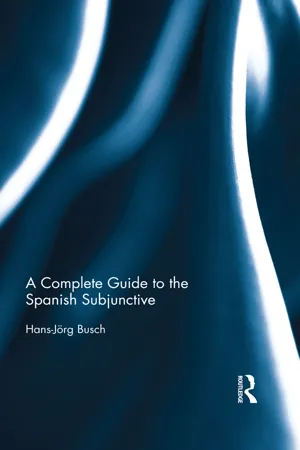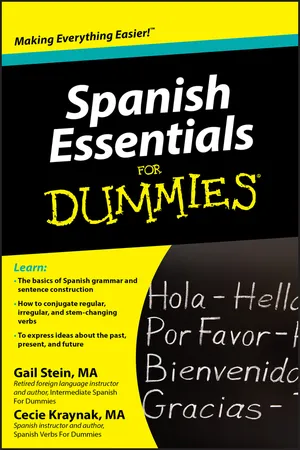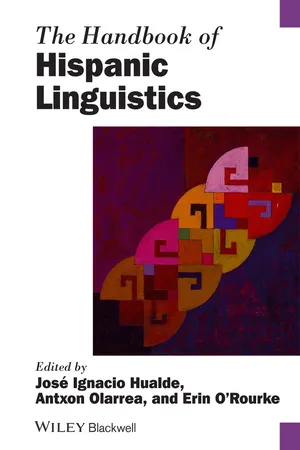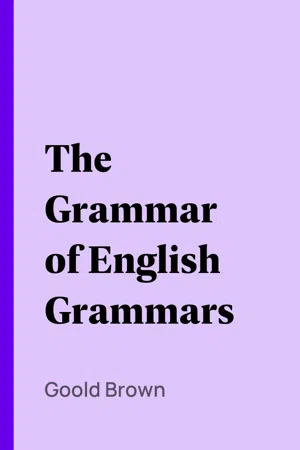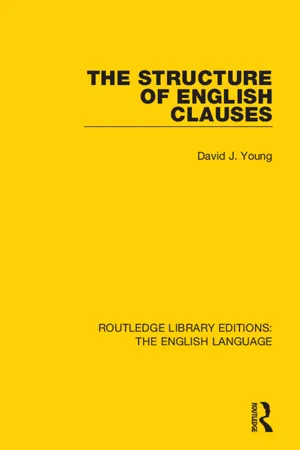Indicative Mood
The indicative mood is a grammatical mood used to make factual statements or ask questions. It is used to express certainty, reality, or truth. In many languages, the indicative mood is the most commonly used mood for expressing simple statements and asking straightforward questions.
5 Key excerpts on "Indicative Mood"
- Hans-Jorg Busch(Author)
- 2017(Publication Date)
- Routledge(Publisher)
...7 The function or systematic grammatical meaning of the indicative, subjunctive, and imperative moods in Spanish By defining moods as the formal and systematic manifestations of modality, they are characterized as grammatical structures with a general modal meaning. This meaning cannot be explained in philosophical, semantic or pragmatic terms, but as a notion that corresponds to all the specific systematic manifestation in the language. Neither can it be defined as triggered by the meaning of other elements or just as the product of distribution rules. 7.1 The formal distinction between indicative and subjunctive in Spanish The basic mood in Spanish is the indicative. Its verb endings and uses distinguish it from the subjunctive and the imperative. The formal distinction between the present indicative and subjunctive is minimal. It is just based on the distinction between the phonemes versus allophones /a/, /e/ and /i/. The same goes for the difference between the imperfect and the imperfect subjunctive (past subjunctive) of regular -ar verbs that are only distinguished by the phonemes [b] and [r]. This is similar to how we use phonemes to distinguish words with different meaning, such as fAn and fUn, bOOt and bOAt, haPPy and HaRRy, etc. Therefore, it is important for teachers to train their students to hear the phonetic difference between [a] and [e] and to point out the importance of this phonological distinction in the Spanish language. The subjunctive paradigm is in many ways more limited and restricted when compared to the indicative: There are only two simple subjunctive conjugations – if we ignore the differences between the two imperfect subjunctive forms hablara/hablase : 1 the present and past subjunctive...
- eBook - ePub
- Gail Stein, Mary Kraynak(Authors)
- 2010(Publication Date)
- For Dummies(Publisher)
...Chapter 8 Identifying Verb Moods In This Chapter Issuing commands Understanding the present subjunctive Speculating with the present perfect subjunctive Using the conditional I n other chapters in this book, we cover verb tenses (past, present, future, and so on). In this chapter, we explain different moods of verbs. No, we don’t mean angry or excited verbs. A verb’s mood reflects the subject’s attitude toward what the verb expresses. Moods come in four flavors: The Indicative Mood, the most commonly used, states a fact and requires the present, past, or future tense. (See Chapters 3, 6, and 7 for more on these tenses.) The imperative mood requires a command. The subjunctive is a mood that shows wishing, wanting, emotion, need, or doubt (among other things) and requires special verb forms. The conditional mood indicates what would happen under certain circumstances. In this chapter, we focus on commands, the present and present perfect subjunctive, and the conditional moods. Giving Commands with the Imperative Mood When you tell a waiter to bring you water, ask a dinner guest to please pass the salt, or tell your dog to lie down, you’re using the imperative mood. You’re giving a command — telling someone, or sometimes yourself, to do something. In most cases, you bark out commands in the you form, but remember that in Spanish you can mean any of four different you s. With the imperative, you can also give what is called a let’s command, as in, “Let’s go to the movie.” This less assertive form of the imperative takes the nosotros form. Forming commands with Ud. and Uds. When forming the formal you singular, that is, the usted (Ud.), commands in the affirmative and the negative forms, you drop the -o ending of the yo form, and add an -e for -ar verbs or an -a for -er and -ir verbs...
- eBook - ePub
- José Ignacio Hualde, Antxon Olarrea, Erin O'Rourke, José Ignacio Hualde, Antxon Olarrea, Erin O'Rourke(Authors)
- 2012(Publication Date)
- Wiley-Blackwell(Publisher)
...al. (1986), Bosque (1990), Porto Dapena (1991), and Ahern (2009), among others. Extensive chapters are devoted to the description of moods in recent grammars of Spanish. See Ridruejo (1999), Pérez Saldanya (1999) and RAE-ASALE (2009: ch. 25). General presentations of the subjunctive mood in current theoretical linguistics may be found in Portner (1999), Quer (2005), and Laca (2010). Studies on Spanish moods from pragmatic, functional, or discourse-oriented perspectives include Lunn (1989, 1995), Mejías-Bikandi (1994), Maldonado (1995), Gregory (2001), Haverkate (2002), and Travis (2003). Since I will not be able to address all the questions raised in these works, I will point out the main issues that I consider to be central, and also the controversial questions that I think are alive nowadays, focusing on those which seem to be particularly relevant for present-day theoretical concerns. Both presentation and discussion of these matters will have to be necessarily schematic. Some relevant, grammatical issues, such as the relationship between mood and tense, will not be addressed here for reasons of space (see Chapter 18, above). There is an almost universal agreement on the fact that Spanish has three moods: indicative, subjunctive, and imperative. With many verbs, imperative forms are pre-empted by others, either from the indicative (Por favor, canta ‘Please, sing’), or the subjunctive paradigm (Por favor, canten ‘Please, sing’), acquiring illocutionary force in both cases. The indicative is the verbal mood chosen “by default”, in the sense that it may appear without a trigger in main or subordinate clauses. The imperative mood is restricted to matrix clauses, as in Ven aquí ‘Come here.’ It is incompatible with negation and with the subordinate conjunction que in these clauses: (1) a. Quiero que {*ven/vengas}. ‘I want you to come-IMPER./come-SUBJ.’ b. No {*ven/vengas}. ‘Do not come-IMPER./come-SUBJ.’ c...
- eBook - ePub
- Goold Brown(Author)
- 2004(Publication Date)
- Perlego(Publisher)
...In the nature of things, however, all being, action, or passion, not contemplated abstractly as a thing, belongs to something that is, or acts, or is acted upon. Accordingly infinitives have, in most instances, a reference to some subject of this kind; though their grammatical dependence connects them more frequently with some other term. The infinitive mood, in English, is distinguished by the preposition to; which, with a few exceptions, immediately precedes it, and may be said to govern it. In dictionaries, and grammars, to is often used as a mere index, to distinguish verbs from the other parts of speech. But this little word has no more claim to be ranked as a part of the verb, than has the conjunction if, which is the sign of the subjunctive. It is the nature of a preposition, to show the relation of different things, thoughts, or words, to each other; and this "sign of the infinitive" may well be pursued separately as a preposition, since in most instances it manifestly shows the relation between the infinitive verb and some other term. Besides, by most of our grammarians, the present tense of the infinitive mood is declared to be the radical form of the verb; but this doctrine must be plainly untrue, upon the supposition that this tense is a compound. OBS. 2.—The Indicative Mood is so called because its chief use is, to indicate, or declare positively, whatever one wishes to say. It is that form of the verb, which we always employ when we affirm or deny any thing in a direct and independent manner. It is more frequently used, and has a greater number of tenses, than any other mood; and is also, in our language, the only one in which the principal verb is varied in termination. It is not, however, on all occasions, confined to its primary use; else it would be simply and only declarative. But we use it sometimes interrogatively, sometimes conditionally; and each of these uses is different from a simple declaration...
- eBook - ePub
- David J. Young(Author)
- 2015(Publication Date)
- Routledge(Publisher)
...5 Mood 5.1 The meaning of mood Mood is the name given to those grammatical systems that express the speaker’s relation to a proposition, but this kind of meaning does not concern only the speaker and the proposition. Speakers take up attitudes towards what they are saying for the sake of communicating with other people; addressees are necessarily involved, and the speaker may impute to the addressee some relationship to the proposition. Thus if a speaker asserts 1 he will ordinarily believe that the addressee needs telling: 1 This is Bill’s house 2 Is this Bill’s house? Similarly if he asks the question in 2 he is imputing to the addressee knowledge of whether or not this is Bill’s house; otherwise he would not have asked. The speaker, in fact assigns roles in the process of communication to himself and the addressee. There are, of course, many other meaningful choices than simply that between declarative and interrogative. In the course of the next few chapters we shall see what these are. For the present we will look at the ways in which the most basic moods are signalled. 5.2 Basic moods In section 2.7 there is a system network for the clause...
